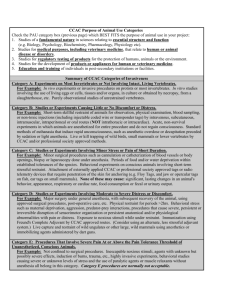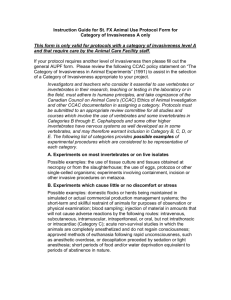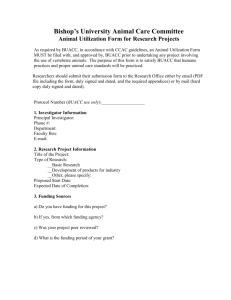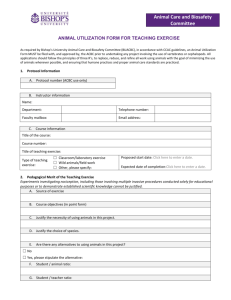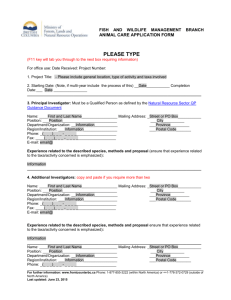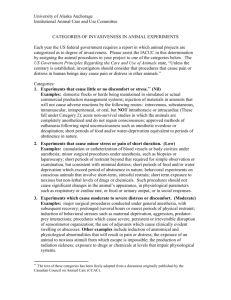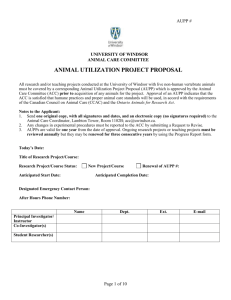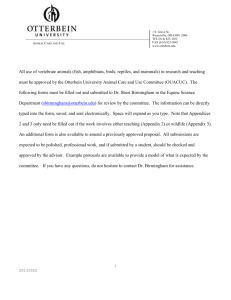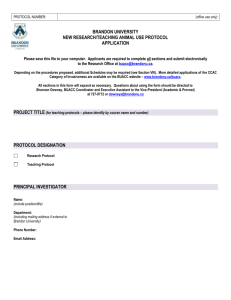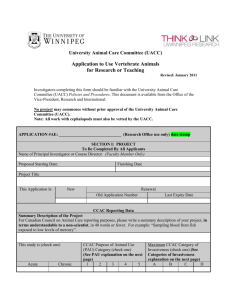appendix 1
advertisement
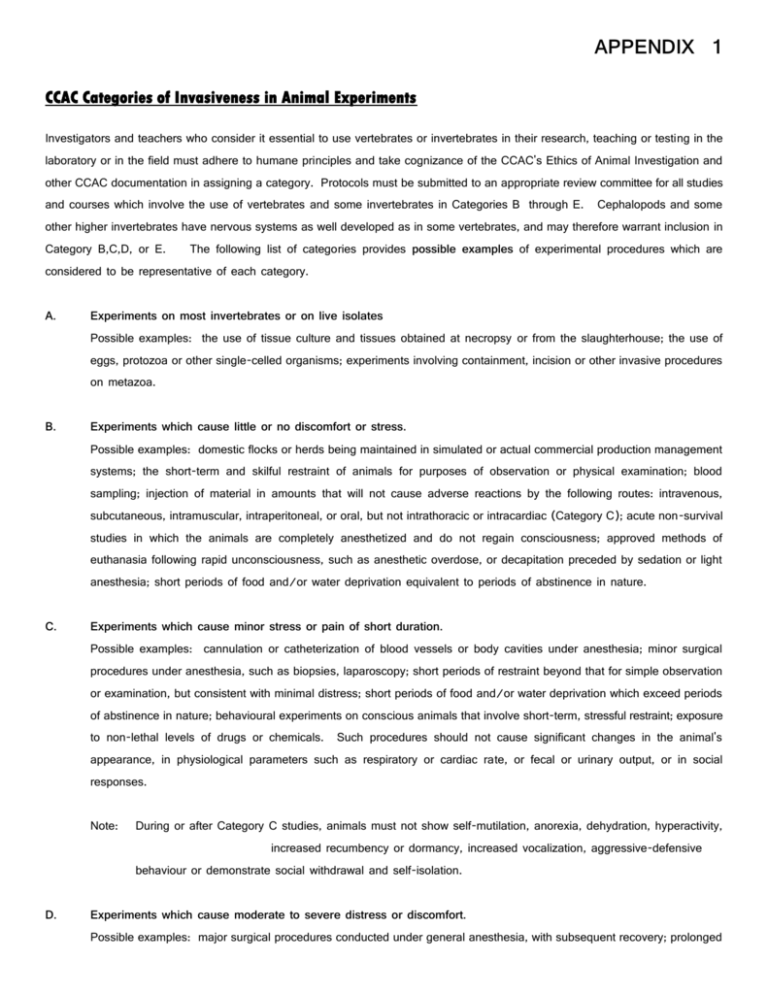
APPENDIX 1 CCAC Categories of Invasiveness in Animal Experiments Investigators and teachers who consider it essential to use vertebrates or invertebrates in their research, teaching or testing in the laboratory or in the field must adhere to humane principles and take cognizance of the CCAC's Ethics of Animal Investigation and other CCAC documentation in assigning a category. Protocols must be submitted to an appropriate review committee for all studies and courses which involve the use of vertebrates and some invertebrates in Categories B through E. Cephalopods and some other higher invertebrates have nervous systems as well developed as in some vertebrates, and may therefore warrant inclusion in Category B,C,D, or E. The following list of categories provides possible examples of experimental procedures which are considered to be representative of each category. A. Experiments on most invertebrates or on live isolates Possible examples: the use of tissue culture and tissues obtained at necropsy or from the slaughterhouse; the use of eggs, protozoa or other single-celled organisms; experiments involving containment, incision or other invasive procedures on metazoa. B. Experiments which cause little or no discomfort or stress. Possible examples: domestic flocks or herds being maintained in simulated or actual commercial production management systems; the short-term and skilful restraint of animals for purposes of observation or physical examination; blood sampling; injection of material in amounts that will not cause adverse reactions by the following routes: intravenous, subcutaneous, intramuscular, intraperitoneal, or oral, but not intrathoracic or intracardiac (Category C); acute non-survival studies in which the animals are completely anesthetized and do not regain consciousness; approved methods of euthanasia following rapid unconsciousness, such as anesthetic overdose, or decapitation preceded by sedation or light anesthesia; short periods of food and/or water deprivation equivalent to periods of abstinence in nature. C. Experiments which cause minor stress or pain of short duration. Possible examples: cannulation or catheterization of blood vessels or body cavities under anesthesia; minor surgical procedures under anesthesia, such as biopsies, laparoscopy; short periods of restraint beyond that for simple observation or examination, but consistent with minimal distress; short periods of food and/or water deprivation which exceed periods of abstinence in nature; behavioural experiments on conscious animals that involve short-term, stressful restraint; exposure to non-lethal levels of drugs or chemicals. Such procedures should not cause significant changes in the animal's appearance, in physiological parameters such as respiratory or cardiac rate, or fecal or urinary output, or in social responses. Note: During or after Category C studies, animals must not show self-mutilation, anorexia, dehydration, hyperactivity, increased recumbency or dormancy, increased vocalization, aggressive-defensive behaviour or demonstrate social withdrawal and self-isolation. D. Experiments which cause moderate to severe distress or discomfort. Possible examples: major surgical procedures conducted under general anesthesia, with subsequent recovery; prolonged (several hours or more) periods of physical restraint; induction of behavioural stresses such as maternal deprivation, aggression, predator-prey interactions; procedures which cause severe, persistent or irreversible disruption of sensorimotor organization; the use of Freund's complete adjuvant (see CCAC Guidelines on Acceptable Immunological Procedures). Other examples in include induction of anatomical and physiological abnormalities that will result in pain or distress; the exposure of an animal to noxious stimuli from which escape is impossible; the production of radiation sickness; exposure to drugs or chemicals at levels that impair physiological systems. Note: Procedures used in Category D studies should not cause prolonged or severe clinical distress as may be exhibited by a wide range of clinical signs, such as marked abnormalities in behavioural patterns or attitudes, the absence of grooming, dehydration, abnormal vocalization, prolonged anorexia, circulatory collapse, extreme lethargy or disinclination to move, and clinical signs of severe or advanced local or systemic infection, etc. E. Procedures which cause severe pain near, at, or above the pain tolerance threshold of unanesthetized conscious animals. This Category of Invasiveness is not necessarily confined to surgical procedures, but may include exposure to noxious stimuli or agents whose effects are unknown; exposure to drugs or chemicals at levels that (may) markedly impair physiological systems and which cause death, severe pain, or extreme distress; completely new biomedical experiments which have a high degree of invasiveness; behavioural studies about which the effects of the degree of distress are not known; use of muscle relaxants or paralytic drugs without anesthetics; burn or trauma infliction on unanesthetized animals; a euthanasia method not approved by the CCAC; any procedures (e.g. the injection of noxious agents or the induction of severe stress or shock) that will result in pain which approaches the pain tolerance threshold and cannot be relieved by analgesia (e.g. when toxicity testing and experimentally-induced infectious disease studies have death as the endpoint). Revised Feb 1991
